Louvre Museum: Mesopotamia and Egypt
- Laurie Seban
- Dec 28, 2022
- 27 min read
Updated: Apr 1, 2024
Highlights of the Louvre's celebrated antiquities in the Mesopotamian and Egyptian departments. The history and cultural themes of each area are explored through key artworks in the collection.
With over 380,000 objects (35,000 on display), the Musee du Louvre is the largest art museum in the world. A collection so vast, it would take 2 months (and 8 miles of walking) to look at every object in the collection. Like the Metropolitan Museum in New York or the British Museum in London, it is an encyclopedic collection, a “world museum” which displays the history and range of global civilizations. Museums like these originated with global empires as a means of putting their wealth and power on display. And while the colonial philosophy that underpinned the collections is now disputed, the lure of the collections is not; pre-Covid, over 9 million visitors passed through the Louvre each year, making it the most visited museum in the world.
What can you see in a single visit? A visitor has 2 choices: wander through the galleries as one would browse through an encyclopedia. You can treat your stroll through the galleries (and the crowds) as a form of meditation; you won't be disappointed by the extraordinary pieces you will inevitably meet (use the Paris Museum Pass and you can come back several times). Or choose a targeted path that will highlight the treasures of the museum. Even a full day will not give you enough time to wind your way through the maze of corridors and mass of visitors to see everything, so decide in advance what is the most important to see. The Egyptian and Mesopotamian collections are some of the best in the world, while the Greek and Roman halls house some iconic masterpieces. And of course there are the European paintings, including the Mona Lisa.
Begin with the museum itself. The Louvre began as a fortress for King Philippe Auguste around 1200--you can see the original fortifications and donjon (tower) foundation on the lower level of the museum in the Sully wing. Over the centuries, it was modified by successive kings, and today the entire complex stands as a visual testament to French history, from the original castle and moat to the Renaissance palace, later modified with the Baroque facade of Louis XIV in the interior courtyard (Cour Carree). It opened to the public as a museum in 1793, after the French Revolution.

Today, the massive Second Empire colonnades of the Cour Napoleon, with 86 sculpted figures looking down at the crowds, serve as a backdrop for IM Pei’s glass pyramids. Many people thought of the pyramids (4 total) as incongruous with the building when they were added in 1989, but Pei was actually referencing the Egyptian antiquities collection, Napoleon’s conquest of Egypt, and the formal symmetry of the Louvre’s architecture. While standing in line, you can take photos that highlight the juxtaposition of abstract forms with the stone facades.
Pei's pyramid is an ingenious entrance; it allows visitors to descend into the cavernous lobby below without obstructing (too much) the overall view of the courtyard. You can also enter the Louvre/line through the Place du Carrousel metro (if you enter from the metro, look for Pei’s inverted pyramid/skylight directly below the Place du Carrousel fountain).
BOLDFACE PARAGRAPHS GIVE DIRECTIONS FOR NAVIGATING THROUGH MUSEUM..
*The Louvre is divided into 8 curatorial departments (Mesopotamian, Egyptian, Middle Eastern, Greek, Etruscan and Roman, Sculpture, Paintings, Prints and Drawings). You can visit a single department in a fairly short period of time (1-2 hours), but some of the departments are on multiple floors of the same wing, so it requires a close reading of the Louvre’s directional arrows—and a lot of stairs.
*Note that in Europe, the ground floor is NOT the first floor, so collections are sometimes stacked, in the basement (-1), ground (0) and 1st (1) floors. The entresol is the central lobby you will enter; from there, you can take stairs or escalators to the 0 level of each wing.
*For each department, follow the flag for each department that is posted in the entresol, and from there follow the Sens de la Visite signs. Because pathways and stairways are sometimes blocked or one-way due to crowd control or covid restrictions, it is virtually impossible to create your own path. And with the crowds of people, you’ll feel as if you are swimming upstream. Go with the flow and enjoy the view. Key works found along the way are featured in boldface, along with their room number, though the numbers seem to change each year!
Why does the Louvre have so many iconic works?
The original Louvre collection began with antiquities, and the museum features some of the most iconic and important treasures in the world. For the most part, objects have been acquired from private donors and through the system of partage: French archaeologists received permission from countries like modern day Iraq to excavate sites. In return, the French government and the host country shared (partager means “share” in French) Those finds from ancient palaces, temples, and burials are spectacular, so if you only have a few hours for the museum, spend your time here, to see key moments in our global history.
There are key pieces that were taken through conquest; Napoleon's army shipped back thousands of artifacts, including Hatshepsut’s obelisk at the Place de la Concorde, from Egypt. Other paintings and sculptures were acquired when France controlled Italy. Some items have been identified as being acquired illegally on the black market. Others entered French "guardianship" during the chaos of World War II; some artworks were seized by the German army and others left behind as their original owners fled or were killed during the war . Many (but not all) have been identified by the Louvre, and officials are working to return them to their rightful owners.
Proponents of world museums like the Louvre (Metropolitan Museum, British Museum, etc.) argue that these priceless items are best preserved and most widely seen by the world community in places like the Louvre, where visitors come from across the globe to see arts and artifacts of our shared human heritage.
But today, many question whether the items taken from other countries should be in France, arguing that keeping objects of colonial conquest reinforces and rewards colonialism. Rather, they argue, return those items back to the countries of their origin (a point the film Black Panther made quite vehemently). In fact, the French government has, in recent years, begun a process of determining which items should be returned to their original countries. Many items from Quai Branly, which houses Frances’s spectacular collection of indigenous arts, are now in the process of being returned or shared with their countries of origin.
__________________________________________________________________________________
MESOPOTAMIA
*From the lobby/entresol, start in the Richelieu wing to view the Mesopotamian (Proche-Orient, or “Near East”) collection beginning in 236, or from the Sully Wing beginning in room 300.
Mesopotamia translates to “between the two rivers” (the Tigris and Euphrates rivers), which is modern day Iraq. The region is studded with the capitals of hundreds of Mesopotamian city-states that rose and fell for 3000 years, from roughly 3500 BCE to 500 BCE, as successive waves of people moved into the region (the most recent one being uncoved in 2022!). The galleries show historical figures and mythological beasts, all busy building (and guarding) empires that rose and fell for 3000 years.
In the case of Mesopotamia, French archaeologists have been mining the region since (1800), which is when most of the Louvre objects were acquired. Sadly, since the first Gulf War in 1990, the region has been wracked by warfare again. Looting has always been an issue, but with the Iraqi invasion, the influx of foreigners and devastation of the economy has led to over 2000 objects being taken out of the country each day, an irreparable loss of history and culture. This is a problem that museums are working to combat today, though some museum curators have been accused (and found guilty) of trafficking in stolen goods.

Figures of all sizes greet you in these rooms. Ebih-II, the Superintendant of the city-state of Mari (Syria), sits in constant devotion to the gods (236). He demonstrates typical Mesopotamian style: sensitively sculpted faces with large stylized eyes and hair, youthful muscular bodies and patterned clothing (in this case, it is goatskin). Figures like this are found throughout the sites, especially at the temples/ziggurats, where they served as devotional figures. Royal and divine figures are similar, but usually have clear emblems of kingship: a headdress, beard, weapons or staff, and hieratic scale (the most important always being the largest).
Ebih-II, Mari 2400 BCE
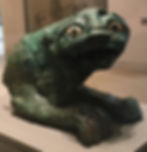
Just as they did in Mesopotamian times, animals real or imagined serve as guardians at temples and palaces. One of the most striking is the glaring Lion from the “Temple of Lions,” an early Mesopotamian site (227). Made of copper with limestone and schist eyes, its ferocious expression with gaping mouth gives a sense of its protective function; it was one of two found leaping from a wall at a temple site near Aleppo (another site currently wracked by war).
Mari Lion, 2500 BCE
The Sumerian cuneiform tablet found in 228 is one of the earliest known systems of writing, and key to our understanding of these cultures.

Cuneiform was developed to track goods as city-states gained power and wealth through agriculture and trade. Clay tablets were incised with a stylus to create distinct geometric characters (cuneiform means “wedge shaped” in Greek). Over time, histories, stories, and religious rites were recorded in permanent form. Although the first cuneiform was Sumerian, as new populations moved into the area, other languages developed the same system of writing.
Cuneiform tablet, Sumeria
Cylinder seal and rollout, Sumeria
Vases depicting the same types of figures were found in burials and used in temple offerings—you’ll see registers (bands) of figures bringing animals or baskets of food as acts of religious devotion. Look for small, awkward looking cylinder seals as well. These were an ingenious method of mass production. The cylinders were carefully carved so that when rolled across soft clay, an imprint appears, making it possible to produce countless images as an act of devotion. Each one is a window into ancient life: offering to a god, a battle between men and beasts (animals, human, or a combination of the two).
Stelae of Naramsin and Hammurabi (227, 228)
Cuneiform lines the back of the 7 foot high Stela of Naramsin (227), notable for the pink color of the stone. This is the first monument to a specific military victory: Naramsin, the king of Akkadia, recorded his conquest of the neighboring Lullubrians in (2250 BCE) in cuneiform script on the back. Naramsin is the largest figure, with horned helmet, beard and weapons, trampling on his enemies as he presents his victory to the gods, represented by the two planets/suns. Look for the enemy who helpfully guts himself on the right, another sign of royal power.
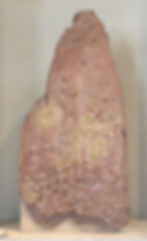
Eventually, the Akkadians were conquered by the Elamites who, as a measure of their power, carted off this stela. In fact, most of the items found in these galleries were not excavated from their original sites. A victorious leader would often export the most important sculptures, especially those of gods and leaders (today we call that archaeology!). As kingdoms waxed and waned over the centuries, statues of leaders and gods circulated throughout the region, which accounts for the uniformity of style.
Stela of Naramsin, Sumeria (2250 BCE)
Stela of Hammurabi, Babylon (1750 BCE)

The 7 ½ foot high Stela of Hammurabi is next door (228)—the first written legal code in the world. Hammurabi, leader of the Babylonians from 1792-1750 BCE, standardized the settling of disputes so that “the strong may not oppress the weak….and the weak the strong.” Hammurabi represented this as a gift to the gods in a dark diorite stela. He stands with beard and headdress of kingship, presenting his code in 4100 lines of cuneiform text to the larger seated god, Shamash.
Essentially Hammurabi codified the principle of “an eye for an eye” that was later copied by the Bible. One law not copied: a woman charged with adultery could prove her innocence by being dropped into the water. If she floated and survived, she was innocent. If she sank and drowned, she was guilty. This may sound harsh, but this is an improvement on the treatment of women in most ancient and even some modern societies! And it’s notable for the idea of an objective system of laws that could be applied to all people within the kingdom.
600 years after its creation, Hammurabi’s stela was taken to the Persian capital of Susa. Over two thousand years later, in 1902, it was taken to the Louvre—and its significance is such that replicas of it can also be found at the U.S. Capitol, and the United Nations.
Assyria was the last major Mesopotamian empire, a culmination of 2000 years of conquest and warfare. In 883 BCE, Ashurnasirpal II in 883 BCE knit together an empire that included most of Mesopotamia, Persia, Arabia and the Middle East; under later rulers, the empire expanded into Turkey, the Mediterranean, and North Africa. Evidence of their success: palaces across the empire. The French consul to Iraq discovered the palace at Mosul in 1843, and parts of that palace, the legendary Dur-Sharrakun, are reconstructed here in the Khorsabad Court (229). At Durr-Sharrakun, Sargon II erected a fortified palace over 1 square mile, with over 200 courtyard and 147 towers.

Walls carved in relief were meant to inspire awe in anyone preparing to enter the chambers of the king. Most spectacular are the 28 ton Lamassu of Sargon II which guarded the palace entrance at Khorsabad. With the body of a lion, wings of an eagle, and head of a man (in this case, the ruler), lamassu were royal protectors throughout the Assyrian empire. The king’s eyes are undercut, so they appear to follow the visitor as they enter the royal chamber.
And as you walk through, how many legs do you see? The lamassu is designed with 5 legs, so from any position, you can see at least 4 legs.
Assyria: Khorsabad Court with Lamassu, Gilgamesh with Lion

Next to a lamassu, the ancient hero Gilgamesh holds a lion—he was subject of the first major text in the world, the Epic of Gilgamesh It detailed his conquest of people and beasts in his quest for eternal life. The image here, of a king hunting lions as a measure of power is seen across Mesopotamia and Africa. Look carefully and you’ll see not just patterns, but also cuneiform covering the surface of the creature.
Panels from the palaces show other representations of power. The Relief of Ashurbanipal II from Ninevah shows the ruler directing timber from Lebanon, in the typical Mesopotamian synthesis of stylization (hair, beard, body, clothes) with naturalism--look at how the toes curl over the bottom edge of the panel!
Ashurbanipal in Ninevah
*The middle galleries which connect the Richelieu wing to the Sully wing show other Mesopotamia city-states.

Gudea of Lagash is notable for the ubiquity of his portraits sprinkled throughout the Sumerian capital of Lagash,and museums today. Look for his large eyes and “beanie” of kingship. The Louvre hosts pieces of a dozen or more Gudeas in a single gallery (305), each noting different achievements. One seated statue shows him holding his plans for a temple, cuneiform extolling his accomplishments covering the skirt of his robe. A standing statue shows him holding a vase, waves of water flowing downwards--just as today, control of water and irrigation was key to power and wealth.
Gudea of Lagash, Sumeria 2150 BCE

Susa, a neighbor to the east (in modern day Iran), was part of the early Achaemenid empire. By the time of Cyrus the Great in 559 BCE, the Persian Empire had expanded to encompass Egypt and most of Mesopotamia (including Assyria), all of which was overseen by the king at the new capital of Persepolis. The Palace of Darius at Susa (308) is just one of many built by Darius and his son Xerxes (son and grandson of Cyrus) around 500 BCE, similar to the even larger palace at Persepolis. Excavations by the French government began in 1885, and much of the palace has been reconstructed in the museum.
The walls that have been exported to the museum were made from molded clay bricks (the original legos!) and glazed in vivid blue and yellow, similar to those found at Persepolis and also ancient Babylon. The style of figures is also the same as in other parts of Mesopotamia—large eyes, stylized beards and clothing. The Wall of Immortals, all in constant obeisance to the Persian kings, give a sense of the pomp and ceremony of the Persian empire.
Persia: Wall of Immortals and detail, Lion wall from Palace of Darius, c. 500 BCE
And animals still serve as guardians. One of the most stunning is a wall found intact at Susa. The glazes have worn away, creating a variegated almost abstract composition of a lion—a glimpse of the sophistication of the Persian empire.
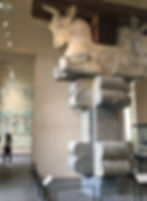
The original palace roof was supported by colossal columns, each crowned by a massive Bull Capital or other animal. Imagine an animal on that scale, perched atop a 45 foot column! Lamassu and lions gracing the walls of the palace.
Persia is what many modern day Iranians most closely identify with (Islam and Arabic was introduced over a thousand years later). For good reason: the religious tolerance practiced by the Persians (in contrast to Iran’s current government) was one of the reasons for its success. Achaemaenid artisans were celebrated for their delicate ceramics and exquisite metalwork, with many more man/animal combos similar to the lamassu.
Bull Capital from Persepolis, c. 500 BCE
Darius and later Xerxes set their eyes on the wealth of the Greek city-states, and their attempted invasions dramatically weakened the Persian Empire. Eventually, Persia was annexed into first Alexander the Great’s empire, then ruled by the Seleucids (more on them in the Islamic galleries).
*As you complete your tour of Mesopotamia, you’ll pass through the galleries (315) devoted to the Levant, that area of northeastern Africa, western Asia and the eastern Mediterranean which has been a crossroads of cultures for millenia.
These galleries show influences from across the ancient world: Phoenician women from Africa are in the style of Minoan Crete, and a Golden Pectoral from Byblos mimics Egyptian style.
Phoenician Woman, Africa Golden Pectoral, Byblos (2150-1550 BCE) Portrait heads from Palmyra
A wall of Portrait Heads are from Palmyra, a once-thriving city in North Africa at the nexus of several ancient trading routes (315). Unfortunately, museums are almost the sole repository of these artifacts today, as Palmyra is situated in Syria, and the ongoing civil war has obliterated many of the sites.
The Palmyran Trio of Gods (sky, moon, sun) dressed as Roman officers are some of the last witnesses to a long and storied history--and a hint of the Greek and Roman departments ahead.

Trio of Gods, Palmyra (c. 1st century CE)
_________________________________________________________________________________________________
EGYPT
*Egyptian Antiquities in the Sully Wing are one of the most visited sections of the museum—but difficult to access!
* Follow the signs from the lobby into the Sully Wing, or you can reach the lowest level of Egypt by passing through the Palace of Darius into Egypt (317), or going through Greek Antiquities to 337 on the other end of the wing. Because of the high volume of visitors in this area, you can only walk in one direction, so follow the signs.

Pyramids (and mastaba tombs) at Giza (2650-2400 BCE)
Egyptian civilization began on the banks of the Nile around 3000 BCE (same time as Mesopotamia). Villages spring up along the length of the Nile and quickly grew, blessed by the regular inundation of the Nile which deposited fertile soil along the riverbanks. Sometime around 3100 BCE, the entire length of the Nile was unified into the Upper and Lower Kingdoms of Egypt. Egyptian kings typically wore a “double crown” that combined emblems of both regions, to emphasize the unification of the two regions.
Egyptian history spans such a long recorded history (from 3100 BCE to Ptolemaic Egypt during the Roman Empire) that it is divided into the Old, Middle and New Kingdoms. History is also measured in dynasties—and the achievements of each successive king were dutifully recorded in texts and inscriptions on stone, walls and any other surface.
There is a global fascination with Egypt that extends back to antiquity itself. Herodotus spoke of the wonders of the Egyptian pyramids in (450 BCE), and Cleopatra’s 1st century arrival in Rome left the population wonderstruck with its pageantry. Over the centuries, the mystique and the monuments remained, but much of the meaning was lost. Islam was introduced into Egypt in the 9th century, and by the 1800’s, Egyptian as a spoken and written language had been dead for centuries. The vast wealth and artistry of Egyptian culture was only understood when Napoleon entered Egypt and a programmatic excavation of Egyptian tombs began. By the mid 19th century, mills were grinding mummies into mummy dust to be used as a cure-all, and wealthy Europeans regularly toured the pyramids at Giza.
The Egyptian collection of the Louvre stems not so much from Napoleon’s conquest (after his defeat, many of those early objects were appropriated by other countries) but by Europe’s continuing fascination with Egypt. The Rosetta Stone, discovered by French troops in 1790, was key to understanding Egypt (the British took possession of it after Napoleon’s defeat and is now in the British Museum). It is essentially a border marker carved in 3 scripts: hieroglyphs, demotic (an Egyptian shorthand script) and Greek. Using the Rosetta Stone, Jean Champollion was able to decode the hieroglyphs in the 1820’s; hence our understanding of Egyptian culture today (and the reason for language program of the same name). Champollion, in fact, was the first curator of the Egyptian Antiquities department. In many ways, he opened the door into the ancient Egyptian world, a centralized empire with a system of government, religion, and practices that lasted for almost 3000 years.
*The volume of visitors and objects in the Egyptian wing is enormous, so it’s best to follow the Sens de la Visite. Because that changes, the info presented here is chronological, beginning with Room 633--immediately after the end of Mesopotamia, take the corner stairway up one level to Sully 2.

Some of the earliest items are stone cosmetic palettes found in tombs, carved with images of animals and creatures very similar to those found in Mesopotamia (633). The Bull Palette showing a bull trampling enemies repeats the same cycle of conquest seen in Mesopotamia, but now the bull represents the power of the Egyptian king during the predynastic period, unifying Upper Egypt and Lower Egypt.
Bull Palette (3000-2650 BCE)
Multiple display cases show what was needed for eternal life—for all the classes of Egyptian society who could afford it. The painted limestone statuette of Raherka and Meresankh (635) shows the hopes of a married couple for eternal happiness. A Seated Scribe, too, is at work for eternity, with quartz and copper eyes that give an eerie liveliness to the statue.
Raherka and Meresankh Seated Scribe
The tomb mural of Nefertiabet is possibly the daughter of Khufu, whose pyramid (the largest at Giza) is nearby. The young princess is fashionably dressed in leopardskin on a throne carved with animal legs. The wealth of the living was meant to be replicated for the dead, so murals and reliefs were created to represent all the pleasures and pastimes of the dead: playing games, boating, hunting, etc. Egyptian conventions of representation are amazingly consistent over the years: profile face, frontal torso, and profile legs, which accounts for a physically impossible but very recognizable style.
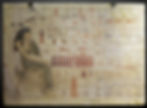
Tomb of Nefertiabet (c. 2490 BCE) Head of Djedefre (2565-2558 BCE)

The Head of Djedefre (635), son of Khufu, is one of the earliest in the collection. As with most agricultural societies, the sun god in the form of Ra, Amun, or a combination of the two ruled supreme over a vast panoply of other gods in Egypt. Each ruler was seen as the living incarnation of Ra and therefore divine. That divine authority was reinforced in many ways. The pyramid tombs, for example, were meant to represent the eternal life of the king, but also the power of the sun god and his own son, the king. Djedefre’s father Khufu built the largest pyramid at Giza. Djedefre ruled for only 8 years (2565-2558 BCE), and his much smaller pyramid is almost entirely in ruins.
Divine authority is represented in a variety of ways. Each king has a distinct and individual face that can usually be recognized across museum collections. Ka statues, which this might be, had to have recognizable faces so that the ka (one part of the soul) had a body to recognize and return to each night. The size of the head (4 feet) is also an indication of his status—the head would have been on a seated or standing statue at his mortuary complex. Djedefre wears a simple linen headdress with a protective cobra (uraeus) extending from his forehead—the classic image of Egyptian kingship.
As you walk through the galleries, you’ll find other emblems of kingship. The king is always largest of course, sometimes carrying a shepherd’s crook or flywhisk, also symbols of his power. If he is not wearing a linen headdress, he might be wearing the flattened crown of Lower Egypt, the domed crown of Upper Egypt, or the Double Crown which represents both. Often, he appears with a “false” beard of kingship—a little more artificial than those found on Mesopotamian kings. In other cases, the king might be represented as Osiris, the king of the Underworld. In Osirid statues, the king appear as a mummy (usually with beard and uraeus), with body wrapped and hands on chest holding the flywhisk and crook.
These symbols of kingship were amazingly consistent over thousands of years. And they seem to have worked: Egyptian pharoahs ruled for roughly 3000 years without any internal revolt or revolution until the empire was conquered by outside groups at the end of the New Kingdom. That is an impressive hold on authority, based on the idea of the ruler’s divine right to rule, and reinforced throughout the galleries, in the panoply of royal images that once covered the public spaces of ancient Egypt.
The Old Kingdom, the age of pyramids, lasted only 500 years (2700-2200 BCE). The amount of labor and resources that were poured into the massive complexes, which included not just the pyramids but mortuary temples, queen’s pyramids, worker camps, even full size boats, might have led to an economic instability that was exacerbated by drought, famine, and eventually political turmoil.
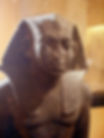
The First Intermediate Period was followed by the Middle Kingdom, a relatively short period of further instability—you can clearly see the wear and tear of the times on the Head of Senwosret III, a Middle Kingdom ruler. After the Second Intermediate Period, the New Kingdom, a 500 year period of large scale building, military expansion, and charismatic leaders, began (1550-1077 BCE).
Hatshepsut (637)
In room 637, an entrance to a temple, complete with colossal papyrus columns (copied by the Greeks 2000 years later!) and images of pharaohs, is physically overwhelming, and gives a small glimpse of this period of temple building. Hatshepsut is responsible for one of the most spectacular, her funerary temple at Deir el-Bahari, in the Valley of the Kings. Yet Hapshetsut was a woman! She was the daughter of Tuthmose I, the sister/wife of Thutmose II, and after his death, the regent for her stepson Thutmose III. But at some point during her regency, she decided to rule herself, as a pharaoh (not a queen)!
Hatshepsut's control was so absolute that she reigned for 20 years (1478-1458 BCE), sponsoring military campaigns into Africa, trade networks across the region, and countless building projects, the most spectacular being Some of those achievements are noted on her obelisk, which was brought back by Napoleon as his emblem of conquest. It now resides at the center of the Place de la Concorde on the other side of the Tuileries.
How did Hatshepsut manage all this? By assuming those same emblems of royal authority. Around the capital of Thebes and at her mortuary complex, countless images of her as ruler were placed—from colossal sphinxes that lined her temple to standing Osirid statues. And while Egypt had other queens (Cleopatra), Hatshepsut always retained her female identity. Female hieroglyphs were always used, and in many sites she is shown as a girl or woman, distinctive with a heart-shaped face, wide eyes, and large ears. In public arts, she was shown with a male body or a female body—but always with those emblems of authority.
Hatshepsut or Thutmose? (1478-1458 BCE)

This transformation was so complete that it is impossible to determine who is represented in the Head of Hatshepsut or Thutmose II (637)—what do you think? The ears have worn away, but the wide eyes, uraeus and conical crown of Upper Egypt remain. It’s striking that Hatshepsut’s divine authority was so absolute, even the rightful heir let her rule for almost 20 years. After a natural death (her mummy has been found and examined), Thutmose III took over and ruled for another 20 years as one of Egypt’s great warrior-kings. But not without methodically defacing and eliminating Hatshepsut’s name from many of her monuments. And sometimes replacing her name with his.

A colossal Head of Amenhotep III from the 18th Dynasty oversees the visitors (along with the feet of an unknown ruler), and gives a sense of how kings were seen. The face is smooth but distinct. In this case, the pursed lips and narrowed eyes give an intense look. He has his own set of royal emblems, a domed crown representing Upper Egypt, and a cobra (uraeus). Like all Egyptian kings, he is eternally youthful (even a pharaoh had to prove his fitness by running around a heb-sed court in a yearly festival.
Head and feet of Amenhotep III(1390-1353 BCE)
Akhenaten & Nefertiti (638)

The small (8”) Double Portrait of Amenhotep IV/Akhenaten and Nefertiti (638) made of painted limestone, shows husband and wife holding hands, with Akhenaten, in crown and uraeus, stepping forward. The iconic features of his wife Nefertiti, as well as her flattened crown (she is the only queen to have worn this crown) are immediately recognizable. Look closely, as this is the beginning of the Amarna revolution. Akhenaten’s body may still be youthful, but he has a bit of belly, and his knock-kneed legs are a little thick, especially in comparison to the diminutive grace of his wife.
Amenhotep IV and wife (c. 1350 BCE)
Shortly after Amenhotep IV began his reign (1353-1336 BCE), he changed his name to Akhenaten. This was truly revolutionary: he discarded the name honoring the sun god Amen, thus disrupting over 1500 years of Egyptian beliefs. Instead, he took on the name Aten, another god representing the sun disc. Even more dramatically, he closed all the temples to Amun in Egypt, and ordered a new, national (and monotheistic) worship of the god Aten, with a new capital built at Amarna. AmenhotepIV--now Akhenaten

These new beliefs were accompanied by a revolutionary new style, today called Amarna naturalism. In comparison to the double portrait, the 4 foot Head of Akhenaten which looms over the gallery (638) is an emphatic statement of those changes. The same emblems of authority remain: traces of a crown and uraeus, a beard, along with the staff and crook held by the mummy (Osirid) statues of Pharoahs. But the face has dramatically morphed into an elongated, almost severe portrait—apparently a more realistic/naturalistic likeness of the Akhenaten.
Other Amarna images show how far this naturalism extends—Akhenaten is usually shown with an elongated head and neck, thin shoulders, flaring hips and a large belly. The source of the style is not known—did Akhenaten suffer from medical conditions? Forensic specialists have theorized a variety of conditions, from Frohlich’s Syndrome to Marfan’s Syndrome, or even possibly hermaphroditism. Another possibility (and the official line of Egypt and the Egyptian State Museum) is that these changes in representation were meant to show the otherworldliness, even androgyny, of a supreme ruler—not any medical issues.
Another equally important element of Amarna naturalism is the emphasis on family. Not the royal family, which would have included the official wife/sister of Akhenaten, but his preferred wife Nefertiti, and their 3 daughters, who are shown in all aspects of family life—not just in the act of worshipping Aten, but in moments of family intimacy as well. A Torso of a female is so distinct in its naturalism that it’s thought to be that of Queen Nefertiti. Akhenaten’s daughter with braid is another.
Female torso (Nefertiti?), Head of a girl (c. 1500 BCE)
The massive changes wrought by Akhenaten were tolerated, at least outwardly, by the entire population. It is only after his death that displeasure was shown in the destruction of Amarna and all associated with it. The capital was razed, the temple to Aten destroyed, and religious life returned as it had existed for a thousand years before, centered around the worship and temples to Amun. But the legacy of Amarna naturalism remains.
You can see Amarna naturalism in the heir to Akhenaten—Tutankhamun. After Akhenaten died, Tutankhaten changed his name back to honor the traditional sun god Amun. After the early death of Akhenaten’s successor, Tutankhamun took power, but reigned only for a short time—his claim to fame rests on the fact that his royal tomb, discovered by Howard Carter in 1928, is the only New Kingdom tomb to be discovered intact. Tut seemed to have died so quickly that his tomb was hastily prepared—but the 4 rooms give a glimpse of the amount of goods a pharaoh would have carried into the afterlife. The Louvre contains just a small amount of the jewelry, figurines, statues that were found.
Amon Protecting (a headless) Tutankhamun (c. 1500 BCE)
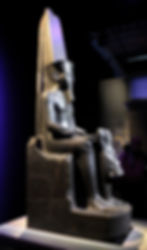
The only artifact associated with Tut (other than those of his father) is the small statue of Amon Protecting (a headless) Tutankhamun in 640.
Tut married Meritaten, the daughter of Akhenaten and Nefertiti; the two infants were their offspring. Royal inbreeding might have been a factor in the deaths of the children—and Tut himself. A comprehensive medical analysis of Tut has determined that he suffered from a cleft palate, malformed leg (which accounts for the 40+ walking sticks in his tomb), malaria and a host of other ailments. It’s only in this century that new examinations of Tut, including the DNA of himself and the two stillborn infants also interred with him, have concluded that Tut was the son of Akhenaten and his sister—the royal wife. Since divine blood was carried through the female bloodline, men took sisters as their official wives to keep power in the family (similar to European rulers marrying cousins to keep power in their respective families). Hence the strong family resemblances one sees in much of the Egyptian dynastic art.
But naturalism came at a cost. Recent excavations in the last decade at Amarna show more evidence of forced labor, maltreatment and malnutrition than any other site in Egypt (far more than at Giza). Because Akhenaten established a monotheistic religion and clearly loved his nuclear family, he has been regarded as one of Egypt’s more enlightened rulers. Apparently not. And it is still an enigma as to why he made such dramatic changes in terms of religion and art.

The names and faces of other pharaohs fill the galleries. In 641, Hathor Welcoming Seti I, a painted limestone mural, shows the goddess Hathor, a protector of pharaohs (identified by her cow horns which hold an image of the sun). Seti I, ruler of the 19th Dynasty, is simply dressed in a linen kilt and sandals, with the uraeus extending its protection. Traces of Amarna naturalism remain—note how the hands are intertwined.
Hathor Welcoming Seti I (1294-1279 BCE)

Not on display now: Maybe you see a family resemblance in the Colossal Statue of Ramses II, the son of Seti and one of Egypt’s great military leaders. Ramses has the same physique as his father, with additional royal symbols: the uraeus, a linen headdress, and false beard of kingship. Hieroglyphs on the back of the black diorite statue extoll the achievements of this extraordinary king, the first to call himself a pharaoh. He ruled for over 60 years (1279-1213 BCE), almost 6 feet in height (and a redhead—his mummy is one of the jewels of the Egyptian State Museum).
Colossal Statue of Ramses II (1279-1213 BCE)
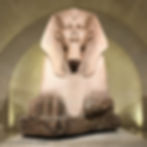
The Colossal Sphinx from Tanis from the Temple of Amun/Ra (338) gives a sense of how imposing sphinxes must have looked lining the route to the Temple of Amun/Ra. What king does it represent? Perhaps several—inscriptions from 12th, 19th, and 22nd Dynasty kings have been identified. Often, kings would recycle earlier monuments but adding new inscriptions. Like the other images of kings, a headdress, uraeus, and beard of kingship are all present.
Colossal Sphinx, Tanis (c. 2600 BCE)
*You will find subterranean Egypt on the 0 floor of Sully, where vast amounts of burial goods are now entombed.
In a stairway annex (327), a lion and 6 life-size sphinxes that once lined the route to the Temple of Amun at Sakkara. As with Mesopotamia, combination animals like the sphinx were meant to convey power and serve as guardians at sacred sites. In this case, they combine the face of the pharaoh with key Egyptian emblems of kingship: a linen headdress, a cobra (uraeus), a beard of kingship, and the individual face of the pharaoh.
Sphinxes from the Temple of Amun
Another descent leads you into the Crypt of Osiris himself (323). Osiris is always represented as a mummy. A Seated Osiris shows him wrapped in linens with arms crossed, holding a shepherd’s crook and flywhisk, a high domed crown on his head, the false beard on his chin. In the crypt, you’ll find a colossal sarcophagus made of stone. This was meant for the protection of the mummy, which was then encased in a series of painted sarcophagi—the more important, the more sarcophagi.
Crypt of Osiris, Sarcophagus with Isis
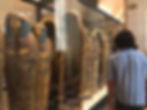
Scores of Sarcophagi with painted faces are vertically stacked, like ancient file cabinets (321). Men and women come to life in the painted portrait faces. And there are sarcophagi for women, too: women in ancient Egyptian society experienced more equity than almost anywhere else in the ancient world (they were able to own property).
Depending on how wealthy you were, mummies could be encased in a succession of increasingly elaborate sarcophagi, made from wood, stone, or a type of papier mache, decorated with images of the dead and hieroglyphs which noted the identity and achievements of the individual, along with blessings for an eternal afterlife.
One of the most striking types of sarcophagi are those found at Fayum, a 3rd century Roman outpost near Cairo. There, wealthy Romans (men and women) had their portraits affixed to their mummies—scores of them have been found. What is so striking is that these Fayum portraits were painted with encaustic—pigmented wax that was placed in layers. All of them follow a type: dark haired with large eyes, each with an intensity of gaze that has not diminished over the centuries.
Fayuum Portraits c. 100 BCE-100 CE
The rest of the galleries bring the dead to life once again. Books of the Dead made of papyrus, some of which are displayed in cases, show the preparations needed in Egyptian times. Egyptians believed in several variants of the soul, but the ba is the one that needed a preserved body to return to after flying around each night. First, the body was dessicated by removing the internal organs, packing the body with natron, and wrapping it in linen.
Canopic jars held the body organs of each mummy. Each set of four contains the heart, stomach, intestines, and liver (the brain was thrown away). Each jar was topped by one of the four sons of Horus: a human, a falcon, a baboon and an ibis.
Other pages on display show what happens in the afterlife: the ceremonial Opening of the Mouth, which allows the soul to escape, or the Weighing of the Heart. The heart of the deceased, representing the soul, is weighed against the feather of justice. If the soul is not weighted down by sin and light enough, the individual can proceed to the afterlife. But if the soul is too heavy, it is immediately eaten by a 3 headed dog.
Book of the Dead with offerings made to Osiris
Presiding over these ceremonies is the king of the Underworld, Osiris, himself the son of the Sun God. According to the histories, Osiris and his brother Seth, along with their sisters Isis and Nepthys, were the first humans—so of course, they could only marry each other. But Seth, jealous of his brother, killed him in a jealous rage. Isis, the sister/wife of Osiris, along with sister Nepthys, went searching for him. She found Osiris, put him back together (the first mummy!), and conceived their child, Horus.
Why is this family drama important to us? Seth becomes the god of chaos and destruction, represented by a hippo; Osiris goes on to rule the Underworld, accompanied by Isis and Nepthys. In Books of the Dead, all three are waiting to greet the deceased. Osiris, as the first mummy, is always represented as such, wrapped in linens with his arms crossed. And Horus, always represented with the head of a falcon, is the one who accompanies the dead to his parent’s abode. Look for a falcon’s head protecting the pharaoh throughout the galleries.
Furniture, games, musical instruments were needed as well (pets, too: the Louvre has several cat mummies in its collection). Ushabti, replicas of human helpers, are seen in eternal service of the wealthy; other figures show the dead in their desired pursuits: hunting, fishing. Replicas of animals, fields, and farms show the wealth not just of kings and nobility, but even of the upper middle class. Mural fragments of paintings and hieroglyphs give a sense of how the actual tombs might have looked—before they were looted by ancient thieves.
Canopic jars, Ushabti, Mural, Scarab
Scarabs, carved from stone, clay, or other materials, are as ubiquitous as they might have been in ancient Egypt. Because the Egyptian scarab (beetle) rolls a ball of dung on the ground, the scarab symbolized the sun god Amun/Ra rolling the sun across the sky. Many of the scarabs wrapped in the mummy linens as amulets are also carved with personal inscriptions. Scarabs are also quite ubiquitous in the gift shop!
Throughout its history, Egypt was an important trading partner with Mesopotamian and Greek city-states. Eventually, under Ptolemy, it was ruled by Greek pharaohs (and queens, like Cleopatra). Its arts laid the foundation for the Greek, Roman and Middle Eastern cultures, from the massive columns of Egyptian temples exported to Greece and Persia to the idealized forms of Egyptian pharaohs and gods that provided the basis for Greek (and later Roman) figures. You can continue your tour of the Louvre in the Greek and Roman sections, which begins in either the Richelieu or Sully wing.



























































